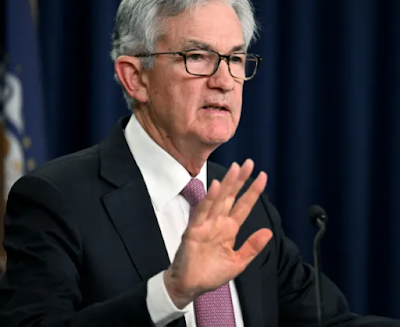The technical tone of the major foreign currencies deteriorated in recent days. It appears to be a cascading effect. Favorite risk-on currencies, like the dollar-bloc, failed to participate in the move against the greenback. The Swiss franc took the dubious honor of being the weakest currency last week, losing 2.2% against the dollar.
Sterling had been flirting with the uptrend line drawn off last June’s lows and rebounds looked increasingly halfhearted and then convincingly broke and traded below the 200-day moving average for the first time in a couple of months.
Of the currencies we examine here, it was the euro, which slipped about 0.15% against the dollar, and the Mexican peso, which was about 0.05% lower over the course of the week, held up the best. The key technical question now is which set of currencies is generating the correct signal: The euro and peso, which suggest that the dollar’s down trend is still intact, or the other currencies that appear to be signaling a dollar recovery is at hand.
We think the preponderance of technical factors favor the dollar recovery scenario. Last week, we assessed the varying degrees that the advance of the major foreign currencies, except the yen, had left them stretched and vulnerable to a reversal. It is in this context that we interpret the recent price action.
To be sure, it is not just that sterling and the Swiss franc are providing lead signals into what is going to happen to the euro. The technical condition of the euro itself looks vulnerable on two grounds. First, there is bearish divergence in the daily (14-bar) relative strength index. This means that the indicator did not confirm the strength of the price action. Second, the dominant short-term chart pattern is a potential double top, with the failure to move above the $1.34 area in the second half of the week. The neckline of the double top comes in near $1.3255. A convincing break is needed to confirm the pattern and project around to around $1.31.
The Mexican peso made a new multi-month high last week, but failed to maintain the momentum. This seems to be a particularly crowded trade, with hedge funds, real money, including the famed Mrs Watanabe the manager of Japan’s household finances, and as the futures data below illustrate, speculators. The relative strength index is showing a dollar-bullish divergence. The MACDs and the slow stochastics appear poised to turn higher. A move above MXN12.70 would likely signal an upside correction that could lift the greenback toward MXN12.90-MXN13.0. The surprisingly dovish central bank comments at the end of last week could be the proverbial drop of tea that overflows the cup.
We took a look at the Dollar-Index. While recognizing that it is heavily weighted toward the euro and currencies highly correlated with the euro, it can generate insight into the dollar’s broader technical tone. The euro’s strength against the dollar has been diluted in DXY by the weakness of the yen and to a less extent the Canadian dollar (and in recent days the Swiss franc). The price action looks constructive, but is not yet causing the bears much pain.
The technical indicators we look at are mixed, with the relative strength index turning higher, neutral MACD readings and fast stochastics have turned up, though the slow reading has not. The 5-day moving crossed below the 20-day, but given the pre-weekend recovery, may cross back to the upside even if there is some consolidation at the start of the week (with the US markets closed on Monday).
To lend confirmation of a more positive technical outlook in general for the US dollar, DXY needs to move above the 80.30-60 area. On the other hand, a convincing break of 79.60-80 on the downside, would call it into question.
There is no compelling technical evidence suggesting that the yen is about to recover. The dollar finished last week above JPY90 and the euro finished just below the JPY120 level. That said, the yen bears seem nervous.
The much anticipated BOJ meeting is a few days away (Jan 21-Jan 22). The market appears to have discounted additional accommodation, with another JPY10 trillion asset purchases, a doubling of the inflation goal to 2%, and possibly the elimination of the interest paid to banks on excessive reserves. The yen was sold in anticipation of these easing moves, it may be bought back on the fact.
We note that in the CME futures markets, the net short yen position has fallen for five consecutive weeks through Jan 15. This is not just a function of shorts covering, but also the establishment of bottom-picking longs. The gross long yen position is the largest since mid-October.
More broadly, the net long foreign currency futures position was increased across the board (with the exception of the yen). However, these new longs were are in weak hands and in the days following the end of the period, these late longs were likely pared.
We also note the net euro position swung back into the long side. It has been flip-flopping over the past few weeks. It seems like a bit of a statistical fluke as the gross shorts continue to be gently trend lower, while the longs that were cut apparently prematurely after the fiscal cliff punt, had to scramble back in.
| week ending Jan 15 |
Commitment of Traders |
|
|
|
(speculative position in
000’s of contracts) |
|
|
|
Net |
Prior Week |
Gross Long |
Change |
Gross Short |
Change |
|
| Euro |
7.3 |
-8.0 |
80.2 |
13.8 |
72.9 |
-1.5 |
|
| Yen |
-65.7 |
-74.1 |
39.4 |
7.3 |
105.2 |
-1.1 |
|
| Sterling |
28.3 |
25.9 |
63.8 |
3.3 |
35.5 |
0.9 |
|
| Swiss Franc |
12.8 |
10.3 |
19.0 |
-0.6 |
6.2 |
-3.1 |
|
| C$ |
68.7 |
64.0 |
73.1 |
2.7 |
4.4 |
-2.0 |
|
| A$ |
89.1 |
80.3 |
137.1 |
14.7 |
48.0 |
8.0 |
|
| Mexican Peso |
152 |
140 |
160.5 |
12.3 |
8.9 |
0.1 |
|
George Dorgan:
We would like to compare with this positions of October 26: Yen short positions have strongly increased, the ones of the euro decreased. There are far more net long positions in the Canadian dollar and the peso now than in the Aussie. The slowing in Asia and the weak Australian trade balances took its toll.
| week ending Oct 26 |
Commitment of Traders |
|
|
|
(speculative position in ‘000s of contracts) |
|
|
Net |
Prior Week |
Gross Long |
Change Gross Long |
Gross Short |
Change Gross Short |
| Euro |
-55.2 |
-53.5 |
38.2 |
-3.9 |
93.4 |
-2.1 |
| Yen |
-18.2 |
10.1 |
25.6 |
-17.2 |
43.7 |
11.1 |
| Sterling |
18.4 |
19.6 |
54.9 |
0.9 |
36.5 |
2.1 |
| Swiss franc |
2.4 |
-1.2 |
10.8 |
0.5 |
8.4 |
-3.1 |
| C$ |
89.1 |
93.8 |
98.6 |
-7.8 |
9.5 |
-3.1 |
| A$ |
45.7 |
38.4 |
83.6 |
5.8 |
38.0 |
-1.4 |
| Mexican Peso |
132.0 |
135.0 |
13.7 |
-3.1 |
4.3 |
-0.1 |
Are you the author?
He has been covering the global capital markets in one fashion or another for more than 30 years, working at economic consulting firms and global investment banks. After 14 years as the global head of currency strategy for Brown Brothers Harriman, Chandler joined Bannockburn Global Forex, as a managing partner and chief markets strategist as of October 1, 2018.
Previous post
See more for 4.) Marc to Market
Next post
Tags:
Bank of Japan,
Canadian Dollar,
Commitments of Traders,
COT,
Currency Positioning,
FX Positioning,
Japanese yen,
Marc Chandler,
MXP,
Net Position,
Non-Farm,
Peso,
Speculative Positions








































